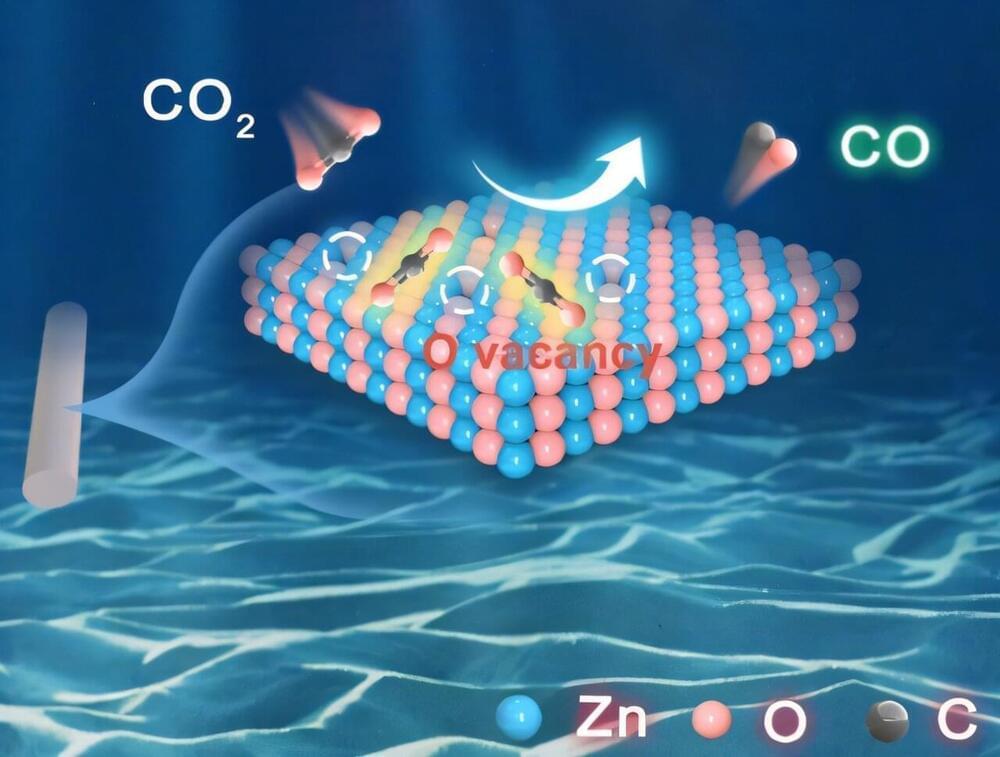Kim Kardashian introduces Tesla’s humanoid robot, Optimus, to her social media followers, sparking widespread online reactions. The playful interactions, including a game of rock-paper-scissors, showcase the robot’s impressive capabilities.



Nano-ZnO is a potential catalyst material for carbon dioxide electrocatalytic reduction (CO2RR), but its effective Faraday efficiency (FE) is still below 90% and the current density is less than 300 mA cm-2, which is not enough to meet industrial requirements.
A new study published in Chem Catalysis reported on ZnO nanorods for electrocatalytic CO2RR, which after 500°C heat-treatment, achieved the highest oxygen vacancy content, the highest FECO of 98.3%, and a partial current density of 786.56 mA cm-2 in a 3 M KCl electrolyte.
The research was conducted by Prof. Wu Zhonghua and Dr. Xing Xueqing from the Institute of High Energy Physics of the Chinese Academy of Sciences (CAS) and Prof. Han Buxing from the Institute of Chemistry of CAS.

Consider the possibility that the terrifying entities portrayed in science fiction films, such as extraterrestrial monsters, could exist in reality. How far would these beings be from our world? In this video, we will explore approximately 20 of these creatures, beginning with those closest to us and progressing to those that are more distant.

Side view of Starship Comparison. 🚀🚀🚀 📷 / artstation.com/dtrford #SpaceX #Starship #Starshiplaunch #Space #CountdownToLaunch #countdown
Graphic / 3D Design.


We may not be the only beings in the universe who use artificial intelligence. That’s according to some astronomers who say that an intelligent civilization anywhere in the cosmos would develop this tool naturally over the course of their cultural evolution.
After 13.8 billion years of existence, life has likely sprung up countless times throughout the cosmos. According to the Drake Equation, which calculates the probability of an existing, communicating civilization, there are currently an estimated 12,500 such intelligent alien societies in the Milky Way Galaxy alone. And if there are aliens who think in a way that we do, and created cultures that developed technology like us, then they probably invented a form of artificial intelligence, too, scientists say.
Assuming AI has been an integral part of intelligent societies for thousands or even millions of years, experts are increasingly considering the possibility that artificial intelligence may have grown to proportions we can scarcely imagine on Earth. Life in the universe may not only be biological, they say. AI machine-based life may dominate many extraterrestrial civilizations, according to a burgeoning theory among astrobiologists.
The universe just got a whole lot bigger—or at least in the world of computer simulations, that is. In early November, researchers at the Department of Energy’s Argonne National Laboratory used the fastest supercomputer on the planet to run the largest astrophysical simulation of the universe ever conducted.
The achievement was made using the Frontier supercomputer at Oak Ridge National Laboratory. The calculations set a new benchmark for cosmological hydrodynamics simulations and provide a new foundation for simulating the physics of atomic matter and dark matter simultaneously. The simulation size corresponds to surveys undertaken by large telescope observatories, a feat that until now has not been possible at this scale.
“There are two components in the universe: dark matter —which as far as we know, only interacts gravitationally—and conventional matter, or atomic matter,” said project lead Salman Habib, division director for Computational Sciences at Argonne.

Stem cells grown in microgravity aboard the International Space Station (ISS) have unique qualities that could one day help accelerate new biotherapies and heal complex disease, two Mayo Clinic researchers say. The research analysis by Fay Abdul Ghani and Abba Zubair, M.D., Ph.D., published in NPJ Microgravity, finds microgravity can strengthen the regenerative potential of cells. Dr. Zubair is a laboratory medicine expert and medical director for the Center for Regenerative Biotherapeutics at Mayo Clinic in Florida. Abdul Ghani is a Mayo Clinic research technologist. Microgravity is weightlessness or near-zero gravity.
“Studying stem cells in space has uncovered cell mechanisms that would otherwise be undetected or unknown within the presence of normal gravity,” says Dr. Zubair. “That discovery indicates a broader scientific value to this research, including potential clinical applications.”
Dr. Zubair has launched stem cell experiments from his lab on three different missions to the ISS. His review paper provides data on the scientific question, “Is space the ideal environment for growing large numbers of stem cells?” Another key concern is whether cells grown in space could maintain their strength and function after splashdown on Earth.
